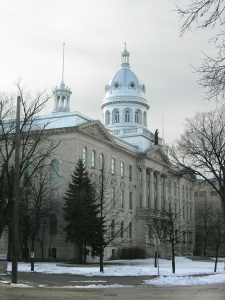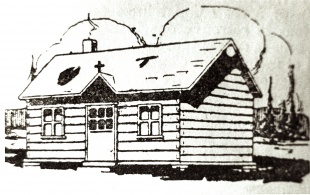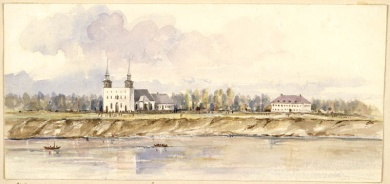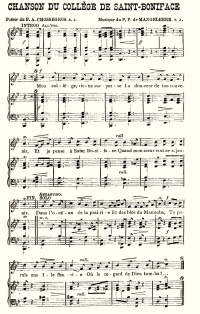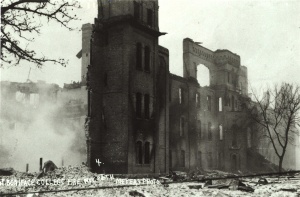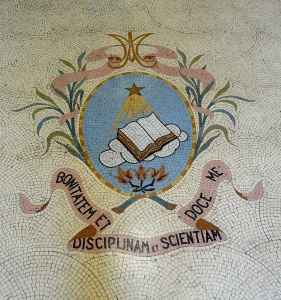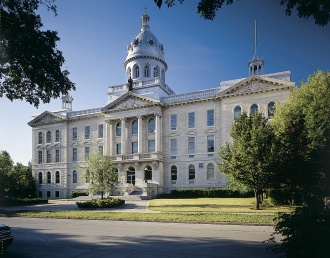The Collège universitaire de Saint-Boniface in Manitoba
par Pelchat, Carole
The Collège universitaire de Saint-Boniface is the oldest post-secondary educational institution in Western Canada. It is located in what is today the heart of Manitoba Francophonie. Its student body, numbering about a thousand, includes francophone students from Manitoba, Québec and the Western provinces, anglophone immersion students, and students from French-speaking countries around the world (West African countries, France, and French overseas territories). The dome of the main building is a cultural landmark and a symbol of the long struggle for French-language education in Manitoba. This article presents the history of this institution, with special attention to the main stages of development since its humble origins in 1818.
Article disponible en français : Collège universitaire de Saint-Boniface au Manitoba
Humble beginnings: 1818-1880
The origin of the Collège universitaire de Saint-Boniface goes back to 1818, with the arrival of Father Norbert Provencher, who came to oversee the Saint-Boniface mission for the purpose of opening the area for colonization, and for educating and evangelizing the Métis and Indians of Red River. In his first year at the colony, Provencher taught reading, grammar, catechism and prayers to young Métis (NOTE 1). The classes took place in his residence, which also served as a chapel and presbytery. The main objective of this humble institution, which was to become the Collège universitaire de Saint-Boniface, was the same as that of the few schools existing in Québec at that time: to recruit young men who would become priests. Teaching was sporadic because of the small number of students and because Provencher was often away setting up missions in the great Prairie region. From 1837 to 1854 secular priests did the teaching, giving classes in the presbytery. Some classes for young boys were provided at the Grey Nuns’ convent.
The College was officially founded in 1855 by Mgr Alexandre Taché, who replaced Mgr Provencher as Bishop of Saint-Boniface. Taché built a building which he handed over to the Frères des écoles chrétiennes (Brothers of the Christian Schools), who were later replaced by the Oblates from 1860 to 1866 and from 1870 to 1878. During this period, Father Georges Dugas O.M.I. organized the classical course of studies which would be offered at the College until the end of the 1960s, with emphasis on the study of Latin, Greek and philosophy. Mgr Taché firmly believed in the importance of the College, and in 1871, a year after Manitoba became a province, the institution was incorporated. “Being incorporated, this college is thus able to adopt its own regulations concerning the language of instruction and of work, which is, of course, the French language” (NOTE 2).
The Collège de Saint-Boniface was thus the first educational institution at the college level in Western Canada. It soon became the centre of French life in the province, with cultural and social events taking place there. In 1877, the College joined with two other colleges in Winnipeg, St John’s College and Manitoba College, to found the University of Manitoba. Two conditions were set by the College: that all rights, obligations and privileges of the College as a Catholic institution be maintained, and that the College, as affiliated with the University of Manitoba, be able to maintain its full autonomy (NOTE 3). A few years later, the University Council created a special program for the students of the College: the baccalauréat ès arts en philosophie latine (Bachelor of Arts in Latin Philosophy). The College thus became a full Faculty within the University of Manitoba (NOTE 4). It is an interesting fact that the University of Manitoba Act makes no provision concerning the use of French as a language of instruction. The only mention is the statement that “The examination for any degree to be conferred by the university may be answered by the candidate in either the English or French language” (NOTE 5).
The belle époque: 1880-1922
The period from 1880 to 1910 was a turning point in the history of the College. In 1880, Mgr Taché undertook construction of a new building in the centre of a twenty-two acre site. As there were not enough Oblates to provide adequate instruction, they were replaced by the Jesuits in 1885. The College, the only Catholic institution of higher learning in Manitoba, served the French and the English Catholic population of Manitoba. Although the city of Saint Boniface did not have a Francophone majority at that time because the Métis had moved away, it was still the main bilingual city in the province. When the College was incorporated, about 50% of the population of Manitoba was francophone. In 1881, however, the proportion was only 15.5%, and ten years later only 6.7% were francophone. They had thus become a minority within a short time. At this time the Manitoba school crisis occurred. In 1890 a law was passed abolishing the teaching of French and of religion in schools. This abolition of French in education was presumably the cause of a drop in student numbers, since students coming from the school system were less prepared for classical studies (NOTE 6).
At the turn of the century, the baccalauréat ès arts consisted of seven years of study during which the following courses were offered: Éléments latins (Latin Rudiments), Méthode (2nd Grammar), Versification (3rd Grammar), Belles-Lettres (Humanities), Rhétorique (Rhetoric), Philosophie I and Philosophie II. To this an eighth year, Syntaxe, was added in 1925. “Another year was needed to strengthen the teaching of French, which was too often deficient in the province’s English-based schools. This lack was gradually corrected by the good work of the Association d’éducation and by the devotion of lay and religious teachers.” (NOTE 7). Usually about a hundred students took the French classical program, about sixty were in the English classical program, about forty in the business program, and more than a hundred in the preparatory classes in English and French. The English program was taken by all students who were not of French origin; they were “English, Irish, German, Polish, Ruthenian, etc. More than fifteen nationalities at once were represented in the classes” (NOTE 8). However, classes in French were always in the majority. Between 1905 and 1922, student numbers were fairly stable at about three hundred, including about a hundred and fifty boarding students. At this time Father Armand Chossegros and Father Paul de Mangeleere composed the theme song of the institution, “Mon collège”. This song promoted the feeling of belonging and of pride in the history of the College. (listen to the audio clip).
Fire and renewal: 1925-1966
On November 24, 1922, a major fire completely destroyed the building and killed ten people, including a teacher and nine students (NOTE 9). As a new college could not be built for financial reasons, Mgr Béliveau, the Archbishop of Saint-Boniface, offered to let the Jesuits continue their teaching on the premises of the Petit Séminaire. This building, built in 1911, is today the oldest part of Collège de Saint-Boniface. Since there were three private teaching institutions at Saint-Boniface, and the diocese could no longer finance them all, the decision to cede the Petit Séminaire was not a great surprise.
“The elimination of the English program was gradual... This elimination, an indirect result of the fire, was in a way a decrease of the College in numbers and in influence. On the other hand, it satisfied the aspirations of both groups. The English-language Catholics were glad to have their own college, run according to their ideas. The French-Canadian group was equally glad to give a more openly national character to its great institution, and to intensify its French culture, which makes it a powerful instrument for the survival of French life in Manitoba” (NOTE 10).
The College had offered a bilingual classical program since 1898, and in 1925, the Jesuits founded St. Paul’s College to provide for young anglophone Catholics. This reduced the number of students by about sixty out of about three hundred. However, the business program was still taught in English until 1941, when it was decided to eliminate the program because there were other business colleges in the city of Winnipeg. In 1938, the College was affiliated with the Institut Saint-Joseph, a college for young women run by the Sisters of the Holy Names of Jesus and Mary. This affiliation made it possible for female students to receive through the College a diploma from the University of Manitoba, even though all the courses were taught at the Institut Saint-Joseph. The early 1960s brought a number of changes, including the arrival of women at the College and the introduction of adult education courses, such as painting and visual arts; the most popular courses were in oral French. In about 1970, the College administration began to develop the university division by offering more courses and by creating the position of Dean of Arts and Sciences. The third change was the arrival of lay people in the College’s operation. In 1962, a board of “advisors” was established to assist the College administration. This board, made up of clerical and lay members, heralded major changes for the future.
Secularization: 1967-1990
After the Jesuits left in 1967, the Archdiocese of Saint Boniface managed the College for two years, with Mgr Antoine Hacault serving as president. During these two transition years, the classical program was abolished, because the teaching of French for 50% of the time had been allowed by the government since 1958. As the College was competing with the public school system, it decided to offer a public secondary program managed by the Saint Boniface School Division. On November 26, 1969, a press release from the president’s office officially announced the secularization of the College. The College Corporation ceded administration and management to a new administrative council made up of twenty members of whom the majority were secular. “The Franco-Manitoban community as a whole also experienced the beginning of an unprecedented period of change at about the same time” (NOTE 11). The College divided its old classical program into two parts, a secondary and a university division, both of which were subsidized by the province. The secondary division was closed in 1983 and transferred to the Collège Louis-Riel. From that time on, the Collège de Saint-Boniface was to concentrate on post-secondary education.
The fact that the College was subsidized directly by the province and was not under the financial supervision of the University of Manitoba allowed it to increase its range of courses and programs. In 1969, the Trudeau government’s Official Languages Act gave the College access to subsidies allocated to bilingualism. In 1971, the College received subsidies from the New Democratic provincial government for the construction of a new building to house a program for certification in education, which later became a bachelor’s degree in education. “The founding of the Institut pédagogique could be partly attributed to a national movement in favour of developing language communities” (NOTE 12) In addition, in 1975, the College founded a community college that granted diplomas in business management and office management, in response to a growing demand for bilingual civil service personnel. New classrooms, a theatre and a library, which was finished in 1976, were added to the existing building. In 1967-1968, all students were native speakers of French; in 1983, 8% of the student body were native speakers of English. By about 1983 the College offered six different diplomas: B.A. (Latin and philosophy), B.A. (general), B.A. (major in French), B.A. (major in translation), B.Ed. (education) et B.S. (sciences).
The Centre d’études franco-canadiennes de l’Ouest (CEFCO), one of whose goals is to encourage research and exchange of knowledge in all areas where Western Canadian francophone action is predominant, was founded in 1978. Its annual colloquia and its journal, the Cahiers franco-canadiens de l'Ouest, advance research on francophone Western Canada. In September 1985 the College opened the Centre de recherches with a view to supporting faculty in their research projects. A few years later, in 1990, the Presses universitaires de Saint-Boniface (PUSB) was founded with the mandate of publishing works of faculty of the College universitaire de Saint-Boniface (CUSB), books and conference proceedings of the Centre d’études franco-canadiennes de l’Ouest (CEFCO), the Cahiers franco-canadiens de l'Ouest, and works about Western Canadian Francophonie.
Today, at the turn of the 3rd millennium
Since the end of the 1980s, there has been a new wave of students: those coming from immersion schools. These new students have raised student numbers at the College. Today international recruitment is increasing as well. This explains the new College expansion, including the sports centre or Sportex. In addition to offering teaching in French, the College wanted to provide other services to serve the francophone community. The 1992 renovation of the premises also increased the number of classrooms. Student services are a great advantage of the College; it promotes activities in French such as the theatre troupe Chiens de Soleil, which was founded in 1989; the Service de perfectionnement linguistique, created in 1989, and the Regroupement des étudiants métis, founded in 2004. In the fall of 2002 the Student Centre opened its doors. This space was designed by the architect Étienne Gaboury, an alumnus of the College. In 2006 a student residence was added to house non-local students. Finally, in 2011 a new health centre building will be completed, to respond to the need for bilingual workers in the area of health, including social services.
Even though it is a small university, the College today encourages research in its strategic plan, including the Canada Research Chair on Métis identity which was obtained in 2004, and a Community-University Research Alliance program launched in 2007, supporting the sector of arts, social sciences and education. Today the College has nearly 800 full-time students and about 500 part-time students, including 189 international students from 24 countries. We have 138 faculty members and 88 other full-time staff. We offer 16 programs of study.
The Collège universitaire de Saint-Boniface has always overcome challenges, whether financial or language-related. The College has clearly surpassed the expectations of its humble beginnings when its aim was to train clergy to ensure the rights of Francophones and Catholics. Today it educates professionals who ensure the revitalization of the French language in Manitoba and other parts of Canada. The College has transmitted a feeling of belonging to its community by continuing to offer programs of study in French, by which it remains at the heart of Manitoba Francophonie.
Carole Pelchat
Archivist, Collège universitaire de Saint-Boniface
NOTES
1. Régnier, 1964, p.14.
2. Hébert, et. al, 1982, p. 29-30.
3. Bernier 1945.
4. Jolicœur, 1985 : 159.
5. Hébert et al, 1982, p. 29.
6. Régnier, 1964, p. 103.
7. Bernier, 1945, p. 44.
8. Anonymous, 1922, p. 229.
9. The ten victims were: Brother Frederic Stormont, age 44; Arthur Taylor, 18; Lawrence Legree, 15; Henri Pélissier, 15; Joseph Guilbert, 16, Léopold Tremblay, 9, John McGlyn, 9, James Duquette, 16, Ovila Laflèche, 16; and Lionel Bouvier, 16.
10. Bernier, 1945, p. 43-44.
11. Legal, 1985, p. 4.
12. Legal, 1985, p. 70.
BIBLIOGRAPHY
Anonyme, « Le Collège de Saint-Boniface : Notes et Souvenirs. » Les Cloches de Saint-Boniface, 21 : 12 (1922), p. 227-230.
Barnabé, Carole, « L'incendie du Collège de Saint-Boniface du 25 novembre 1922. » Cahiers du CEFCO, 9 : 1 et 2 (1997), p. 87-100.
Bernier, Alfred, Les dates mémorables du Collège de Saint-Boniface 1885-1945. Saint-Boniface, Archevêché de Saint-Boniface, 1945, 78 p.
Hébert, Raymond M. et. al, Le statut juridique de la langue française au Manitoba. Historique, effets et avenir, éauche d'une étude commanditée par le Conseil de la langue française du Québec, 1982, 187 p.
Jolicoeur, Gérard, Les jésuites dans la vie manitobaine 1885-1922. Saint-Boniface, Centre d'études franco-canadiennes de l'Ouest, 1985, 260 p.
Legal, Roger, L'évolution du Collège universitaire de Saint-Boniface entre 1967 et 1983 : exposé historique et comparaison de diverses interprétations vis-à-vis de certains changements majeurs survenus. Thèse de doctorat. University of Manitoba, 1985, 303 p.
Léveillé, Roger, « Le rôle du Collège universitaire de Saint-Boniface dans la production culturelle en milieu minoritaire », La production culturelle en milieu minoritaire. Saint-Boniface, Actes du 13e colloque du CEFCO, 1993, p. 91-98.
Régnier, Paul, A History of St. Boniface College. Master's Thesis. University of Manitoba, 1964, 158 p.
Sabourin, J.-Ad, Notre mentalité : catholique et canadienne-française à l'école. Saint-Boniface, Imprimeur Arthur, Arch. Saint-Boniface, 3 mars 1925, 44 p.
Savas, Daniel, « Institutions francophones et vitalité communautaire : motivations symboliques et fonctionnelles du choix de réseau institutionnel » dans les 10e Actes du CEFCO 1990, p. 68-83.
Additional DocumentsSome documents require an additional plugin to be consulted
Images
-
 Collège universitair
Collège universitair
e de Saint-Boni... -
 Colonie de la rivièr
Colonie de la rivièr
e Rouge à Sain... -
 Esquisse du premier C
Esquisse du premier C
ollège de Saint... -
 Façade du Collège un
Façade du Collège un
iversitaire de ...
-
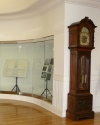 Intérieur du collège:
Intérieur du collège:
vue de la vitr... -
 L’incendie de 1922 (l
L’incendie de 1922 (l
es ruines) -
 Le collège de Saint-B
Le collège de Saint-B
oniface avant l... -
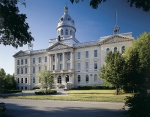 Le Collège universita
Le Collège universita
ire de Saint-Bo...
-
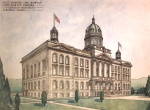 Le petit séminaire de
Le petit séminaire de
Saint-Boniface... -
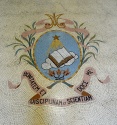 Mozaïque de l'entrée
Mozaïque de l'entrée
principale, ave... -
 Partition de la chans
Partition de la chans
on du Collège -
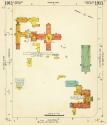 Plan de la ville de S
Plan de la ville de S
aint-Boniface, ...

